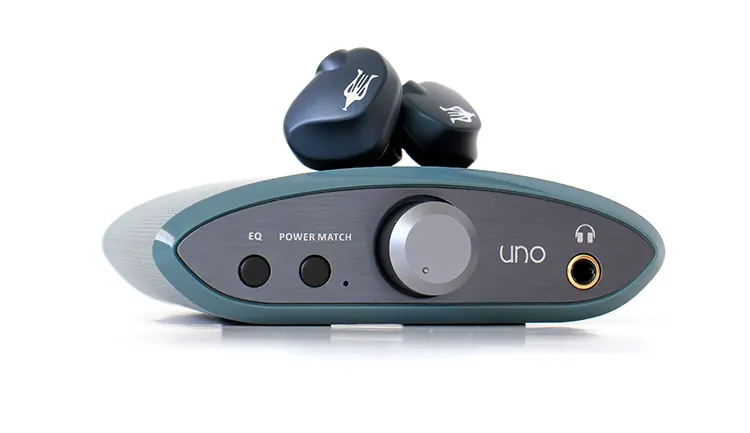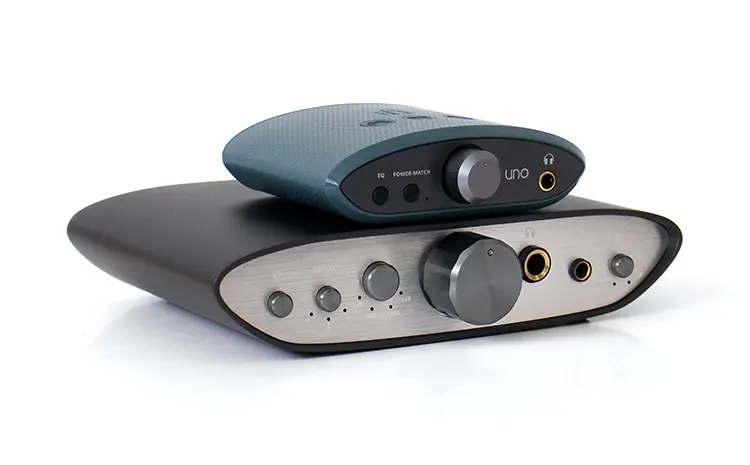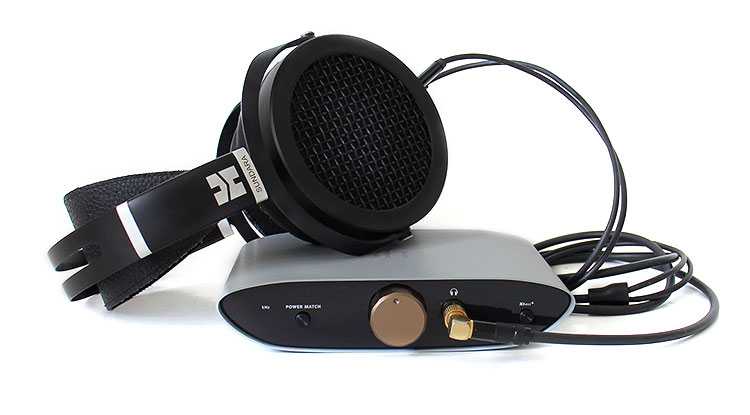Synergy
Power
There’s one important factor that affects the iFi Audio UNO and that’s the amount of power that’s available at the particular USB port you’re using. I ran it using a mobile device and it suppressed the dynamics a bit, especially within the bass region. I suspect it was a lack of power at the source.
So you could use efficient full-sized headphones but make sure you feed the UNO with at least 500mA at 5 volts. If you have a high-power 1 amp or two amp USB port then use them by all means.
While I was using a PC port that’s capable of 1A and 3.2 USB bandwidth I did notice an increase in bass response and performance compared to running off a phone port. So it does work in that scenario but it seems the UNO is geared to work best on a desktop setup anyhow so it fares well in all its initial claims of being a desktop model.
Another important fact I found was that the UNO worked best when I connected the unit straight to a USB port and eliminated any filters or noise eliminators I had.
In my case, I was hearing more stray noise while using the iFi Audio USB iPurifier 3.0 which works great on the iDSD Diablo and the iDSD signature.
Pairing
The iFi Audio UNO has its place and that place is with a set of IEMs and a laptop if you want to go completely portable or as an addition to a home desktop PC and for those who want to improve sound quality without going through the hassle of installing a sound card and pertinent drivers.
I wouldn’t use power-hungry headphones for sure with the UNO and would stick with IEMs. All IEMs seem to like the UNO. The three EQ curves are subtle and worked well with most IEMs I used as well plus the PowerMatch feature most times was content at the low setting with IEMs.
I must have used a dozen IEMs. HIFIMAN’s Svanar, RAI Penta, RAI Solo, Tri I3, FiiO FD5, and Helm Audio’s F2. They all worked well. However, the EQ curves reacted differently with each IEM.
The EQ curves add a fun factor because although you can stick to the safe flat curve. You can always kick in one of the presets, and since the presets never explore saturation levels, the subtle effects can be enjoyable on many occasions, moods, and scenarios.
Select Comparisons
iFi Audio ZEN DAC V1 / V2
Price $129.00-$199.00
Technical
The ZEN DAC is the single line of components that truly bought forth iFi’s talent but at a reachable point price-wise for many. It also gave iFi lots of exposure among hobbyists who look for high-ratio bang-for-the-buck audio gear. A title that fits the ZEN DAC very well.
There was an upscale in overall cost from the first version but the rise was reasonable. Version one used an 8-core XMOS processor with a Burr Brown custom DAC section while version 2 upgraded to a 16-core variant XMOS.
Not much else was changed. Both V1 and V2 models have the same IO and the same back panel, and even on paper, they seem to have very similar specs. But version 2 is the current model and the 8-core variant has been phased out as of today.
Design
The obvious visual design cue that stands out is the size, of course. The ZEN DAC is 4 times larger. The other major difference is the all-metal chassis that does well at rejecting stray EMI which seems to be a slight issue with the UNO. That’s the one major benefit that comes from using metal.
Each model, including the UNO use analog volume knobs which inherently have a slight channel imbalance at the bottom 2% of the adjustment range. Both models have the iFi PowerMatch feature but the ZEN DAC has TrueBass instead of Xbass which I prefer because it’s the more subtle one.
To counteract this, the UNO has three selectable EQ curves which beat the TrueBass feature due to the subtlety of the curves and added versatility. For some reason, the TrueBass slightly crosses the line far as the amount of boosting. It’s why I prefer XBass, it’s because of the subtleness of the boost.
Performance
Version one and two didn’t present much of a difference sonically excepting some additional stability from the DAC section and its ability to handle higher bit rates comfortably. Perhaps a small margin in improved staging as well. Features, construction, and most components remained the same.
The one feature that sonically puts the ZEN DAC in front of the UNO is the balanced output plus the balanced input adds, even more, versatility, although it uses 4.4mm Pentaconn connectivity instead of the more desirable XLR. But that’s asking for too much and understandably size restrictions would not allow that.
Another feature that might seem insignificant but it’s worth mentioning. There are definite sonic differences between the available firmware updates that iFi offers for the ZEN DAC. Perhaps at a later date, iFi will offer something similar on the UNO.
So the ZEN DAC offers obvious benefits which certainly are worthy of the extra expenditure. Not only does it offer better sound but it also has a better construction level and more features.
iFi Audio ZEN Air DAC
Price $99.00
Technical
There are many similarities between these two models including the IO, analog volume knob, a set of RCA outputs, and a single USB input but it takes a different route far as internal components. They also share a similar construction far as materials and appearance.
The ZEN Air uses the more traditional iFi componentry which consists of the Burr Brown DAC and the XMOS processor. Specifications are similar between these two models including power output, although the UNO is just a fraction of its size.
Both models are capable of similar digital format rendering capability but the one major feature the Air DAC has over the UNO is a hotter line output which is capable of a 3.3-volt output versus the UNO’s 2.0-volt max capability. So, the UNO would be the best choice if you plan on using the RCA output.
Design
The UNO and the ZEN Air have similar cabinetry construction but the color scheme changes. Now, I’m unsure why iFi went with different color schemes on every component on the AIR line. Perhaps it was done for theatrics or contrast.
Some will like the different color contrast of the various Air components but others would prefer the same color scheme. But then again, this does accentuate their model particularly and makes each component unique.
One of the features I like about the ZEN Air is the additional rear DC power jack which alleviates the source from having to power up the unit. The ZEN DAC has the same feature also but not the UNO since it runs completely off the USB port.
Performance
I rejoiced when I saw the Xbass logo on the iFi Audio Air DAC because it’s my favorite bass boost feature, not only from iFi but from other implementations out there, and it’s because of its subtleness. I prefer it over the ‘TrueBass’ feature on the ZEN DAC.
Although these two models, the UNO and the ZEN Air DAC use different components they sound similar. It seems like iFi tuned them to have similar characteristics and to be honest, both are almost indistinguishable sonically.
You probably won’t get much of a sense of improvement because the ZEN Air DAC does have more driving power in volts but it’s a miniscule amount. The ZEN Air has a specification of 230mW and 3.3 volts max versus 211mW and 3.5 volts off the UNO. So the numbers indicate that the differences are split and too close to call.
I wouldn’t want two siblings to fight over who’s the best but at the present retail cost of the UNO, it makes sense to go with it because of the additional sonic EQ curves, small stature but with an almost exact level of performance.
Unless you need a better RCA line drive, then the ZEN Air can tilt the scale due to the improved ability at that particular task.
Our Verdict
I guess what iFi Audio was referring to all along when they wrote “bigger, bolder, better sound” was to the sound quality level exclusively and they hit that goal if you compare the UNO sound quality to every onboard PC sound, laptop, or mobile device’s audio performance out there.
In that light, the iFi Audio UNO certainly is an improvement over many things. It also makes a great first-timer and an easy-to-transport DAC amplifier. It’s a step above the common dongle DAC if you always wanted similar performance but in a desktop style. The EQ curves are just extra sprinkles.
It seems iFi Audio in this particular case shared the GO Link components, inserted them into a very small desktop-like chassis, and added some features which turned out to be a good idea if you asked me.
Why? Because of the additional three-curve EQ selector, the PowerMatch feature along with an extra set of RCA outputs. Plus, the addition of a volume knob and the pre-out capability easily puts the iFi Audio UNO into the high-value category.
iFi Audio Uno Technical Specifications
- Digital Input: USB-C
- Formats: DSD 256, 11.3MHz / DXD 384kHz / PCM 384k / MQA
- DAC: Bit perfect DSD/DXD DAC by ESS
Line Section
- Output: 2V max
- Output Impedance: 100Ω
- SNR: ≥ 119dba
- DNR: ≥115db @ 0dbfs
- THD+N: ≤ 0.03% @ 0dbfs
Headphone section
- Output: 2.6V 3.5V max at 32Ω
- Output Power: ≥211mW @ 32Ω 39mW @ 300Ω
- Output Impedance: ≤ 1Ω
- SNR: ≥ 113dba
- DNR: ≥ 110db @ 0dbfs
- THD+N: ≤ 0.02% 1.27v @ 16Ω
- Channel Separation: ≥ 80db 1kHz @ 16Ω
- Frequency Response: 10-80kHz -0.5db
General Specifications
- Power Supply Requirements: USB-C 5V/ 0.5A
- Power Consumption: Idle – 0.8W / Max Signal – 1.5W
- Dimensions:88 x 81 x26 mm / 3.5” x 2.8” x 1.0”
- Net Weight: 92 grams / 0.2 lbs
- Limited Warranty: 12 months






